Exploring Façade Diversity: From Glass to Green, Kinetic to Brick

In the realm of architecture, façade design extends beyond mere aesthetics; it serves as a multifaceted element that not only shields a building from external elements but also molds its identity and enhances its energy efficiency. Beyond its functional aspects, façade design communicates the architect’s vision and seamlessly merges form and function, contributing to the urban landscape’s allure. Façade solutions encompass the intricate processes of designing, engineering, and constructing building envelopes that optimize performance, aesthetics, and sustainability.
A Plethora of Façade Systems
Façade design presents a vast canvas, offering a spectrum of choices ranging from traditional materials like brick and stone to contemporary innovations such as glass, metal, kinetic, and green façades. Each type of façade design imparts a unique character and performance to a building.
The Elegance of Glass Façades:
Glass façades have garnered widespread attention in modern architecture due to their sleek and minimalist appearance. They usher in abundant natural light, creating luminous and inviting spaces. While their aesthetic appeal is undeniable, they also possess noteworthy performance characteristics. Advanced glazing technologies provide exceptional thermal and acoustic insulation, bolstering energy efficiency and occupant comfort. Despite their delicate appearance, glass façades exhibit remarkable durability and weather resistance, necessitating minimal maintenance.
The Dynamic Nature of Kinetic Façades:
Kinetic façades represent the pinnacle of façade design innovation. These dynamic façades possess the remarkable ability to adapt to changing environmental conditions. They can dynamically adjust to control the amount of sunlight entering the building, thereby reducing the need for artificial lighting and air conditioning. Beyond their performance benefits, kinetic façades introduce an element of dynamism and excitement to the urban landscape, revolutionizing the interplay of aesthetics and functionality.
Embracing Sustainability with Green Façades:
In the era of heightened environmental awareness, green façades have emerged as a promising solution. These façades, adorned with vegetation, offer numerous environmental advantages. They act as natural air purifiers, absorbing pollutants and releasing oxygen. Green façades also regulate a building’s temperature, reducing energy consumption for heating and cooling. Furthermore, they contribute to biodiversity and provide a serene connection with nature, enhancing both aesthetics and sustainability.
The Timeless Appeal of Brick Façades:
Despite the advent of modern materials, brick façades continue to evoke a sense of comfort and timelessness. Their rich textures and warm hues exude a sense of familiarity and permanence. Brick façades are versatile, suitable for both traditional and contemporary designs. They offer excellent durability, demand minimal maintenance, and provide superior thermal and acoustic insulation, making them a cost-effective choice with enduring appeal.
Championing Energy Efficiency with Double Skin Façades:
In the pursuit of energy efficiency, double skin façades have gained prominence. Comprising two layers, they create an insulating air cavity. Double skin façades excel in thermal insulation, reducing the need for heating and cooling. They also facilitate natural ventilation, enhancing indoor air quality. These façades offer enhanced acoustic insulation, ensuring tranquility within the building and shielding it from the noise of a bustling urban environment. Moreover, they offer flexibility in design, accommodating various aesthetic expressions.
The Future of Façade Design
The landscape of façade design is in constant evolution, with innovative materials, technologies, and concepts continuously shaping its trajectory. Sustainability remains a paramount concern, driving the adoption of green façades and energy-efficient design solutions.
Green Façades and Sustainable Practices:
As environmental consciousness deepens, green façades are poised to become integral components of sustainable architecture. Their ability to improve air quality, regulate temperature, and support biodiversity aligns with the goals of eco-friendly construction. Future developments in green façade technology may make them even more accessible and effective.
Intelligent and Adaptive Façades:
Digital technologies are set to transform façade design with intelligent, adaptive systems. These façades will dynamically respond to environmental conditions, optimizing energy efficiency and occupant comfort. Advanced sensors, automation, and responsive materials will contribute to smarter buildings that seamlessly adapt to their surroundings.
In Conclusion: The Art and Science of Façade Design
Façade design stands at the intersection of art and science, where aesthetics merge with performance, and architecture harmonizes with the environment. As architects and designers continue to explore this dynamic spectrum, the future of façade design promises to be a remarkable fusion of creativity, sustainability, and innovation.
In the ever-evolving landscape of architecture, façade design remains a canvas for artistic expression and a crucible for innovation and technological advancement. As we look ahead, one certainty remains: façades will continue to shape our built environment, influencing the way we interact with and experience the spaces that surround us.





